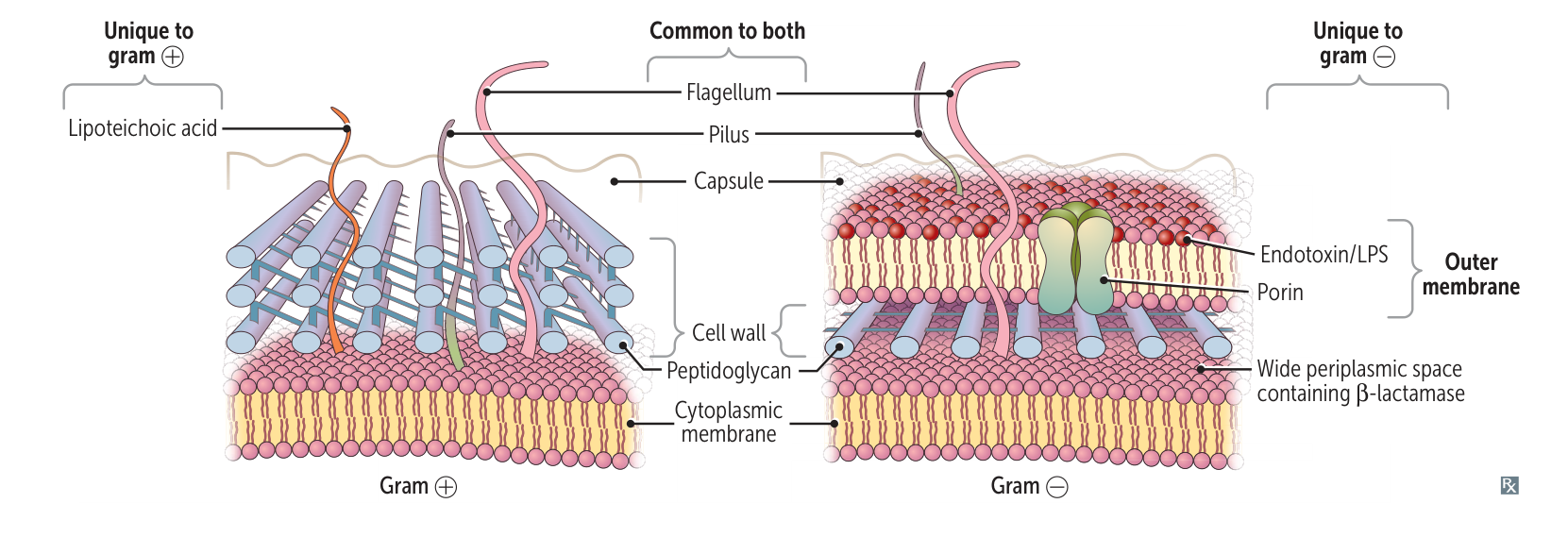Bacterial structures

Cell Wall & Membranes
-
Gram-Positive (+)
- Structure: Thick peptidoglycan layer, single cell membrane. Contains teichoic acid and lipoteichoic acid (LTA). LTA induces TNF-α and IL-1.
- Analogy: A thick brick wall (peptidoglycan) with reinforcing bars (teichoic acids).
- Gram Stain: Retains crystal violet, appears purple/blue.
- Key Features: More susceptible to penicillin.
-
Gram-Negative (-)
- Structure: Thin peptidoglycan layer in the periplasmic space between inner and outer membranes.
- Analogy: A thin brick wall surrounded by a chain-link security fence (outer membrane).
- Outer Membrane: Contains endotoxins.
- Lipopolysaccharide (LPS): The major endotoxin.
- Analogy: The alarm system on the security fence.
- Lipid A: The siren of the alarm system; triggers a massive immune response (shock, fever, DIC).
- O-Antigen: The specific model number of the alarm system, used for identification (e.g., E. coli O157).
- Lipooligosaccharide (LOS): Found in some species (e.g., Neisseria). Has endotoxic Lipid A but lacks the O-antigen.
- Analogy: A generic, but equally loud, motion-detecting siren that lacks a specific model number. Its structural variability helps evade the immune system.
- Lipopolysaccharide (LPS): The major endotoxin.
-
Atypical Cell Walls
- Mycobacteria: Contain mycolic acid. Do not Gram stain; require acid-fast stain.
- Analogy: A waxy, waterproofed wall that repels the purple/pink "paint" of Gram stain.
- Mycoplasma: No cell wall. Cell membrane contains sterols.
- Analogy: A tent with flexible poles (sterols) instead of rigid walls.
- Mycobacteria: Contain mycolic acid. Do not Gram stain; require acid-fast stain.
External Structures
-
Capsule
- Patho/Etiology: A well-organized polysaccharide layer.
- Function: Antiphagocytic virulence factor.
- Analogy: A slippery, invisibility cloak that helps the bacterium evade capture by immune cells.
-
Glycocalyx (Slime Layer)
- Patho/Etiology: A loose, disorganized polysaccharide layer.
- Function: Mediates adherence and forms biofilms.
- Analogy: Sticky glue that helps bacteria clump together and stick to surfaces (like catheters or teeth).
-
Pili (Fimbriae)
- Patho/Etiology: Hair-like proteinaceous appendages.
- Function: Adhesion to host cells. Sex pilus is used for conjugation.
- Analogy: Velcro hooks for grabbing onto host cells. The sex pilus is a "tunnel" for passing genetic information.
-
Flagella
- Patho/Etiology: Long, helical filament for motility.
- Function: Provides movement (chemotaxis). H-antigen.
- Analogy: A motorboat propeller that drives the bacterium through its environment.
Intracellular Structures
- Spores (Endospores)
- Patho/Etiology: Dormant, highly resilient structures formed by some gram-positive rods (Bacillus, Clostridium).
- Key Components: Core contains dipicolinic acid.
- Function: Survival in harsh conditions.
- Analogy: A survival bunker or panic room that protects the bacterium's DNA during a disaster, allowing it to reactivate when conditions improve.